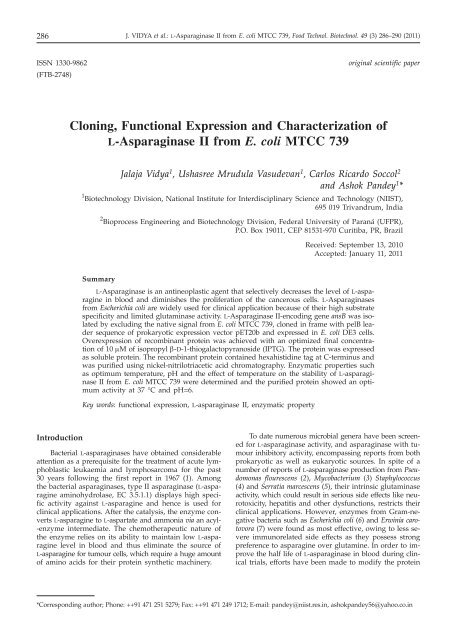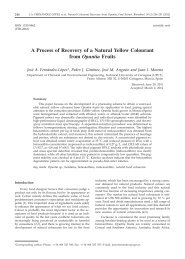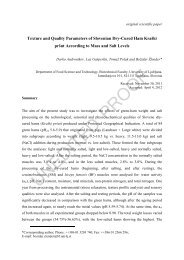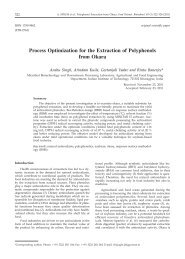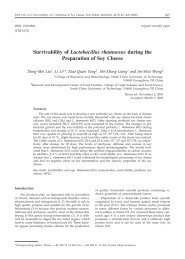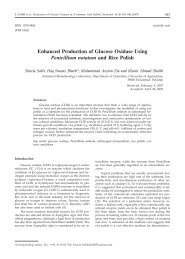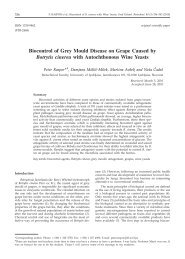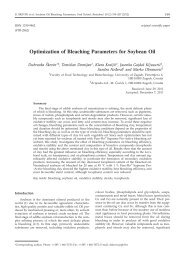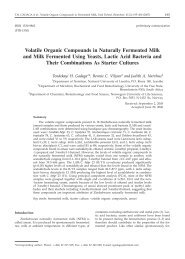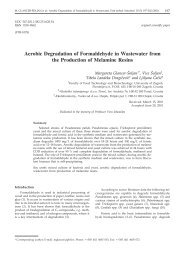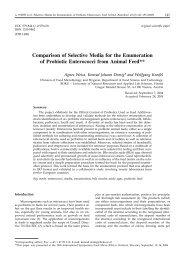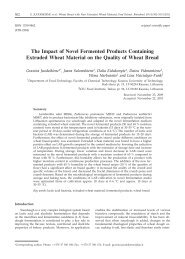Cloning, Functional Expression and Characterization of L ...
Cloning, Functional Expression and Characterization of L ...
Cloning, Functional Expression and Characterization of L ...
Create successful ePaper yourself
Turn your PDF publications into a flip-book with our unique Google optimized e-Paper software.
286 J. VIDYA et al.: L-Asparaginase II from E. coli MTCC 739, Food Technol. Biotechnol. 49 (3) 286–290 (2011)<br />
ISSN 1330-9862<br />
(FTB-2748)<br />
original scientific paper<br />
<strong>Cloning</strong>, <strong>Functional</strong> <strong>Expression</strong> <strong>and</strong> <strong>Characterization</strong> <strong>of</strong><br />
L-Asparaginase II from E. coli MTCC 739<br />
Jalaja Vidya 1 , Ushasree Mrudula Vasudevan 1 , Carlos Ricardo Soccol 2<br />
<strong>and</strong> Ashok P<strong>and</strong>ey 1 *<br />
1 Biotechnology Division, National Institute for Interdisciplinary Science <strong>and</strong> Technology (NIIST),<br />
695 019 Triv<strong>and</strong>rum, India<br />
2 Bioprocess Engineering <strong>and</strong> Biotechnology Division, Federal University <strong>of</strong> Paraná (UFPR),<br />
P.O. Box 19011, CEP 81531-970 Curitiba, PR, Brazil<br />
Received: September 13, 2010<br />
Accepted: January 11, 2011<br />
Summary<br />
L-Asparaginase is an antineoplastic agent that selectively decreases the level <strong>of</strong> L-asparagine<br />
in blood <strong>and</strong> diminishes the proliferation <strong>of</strong> the cancerous cells. L-Asparaginases<br />
from Escherichia coli are widely used for clinical application because <strong>of</strong> their high substrate<br />
specificity <strong>and</strong> limited glutaminase activity. L-Asparaginase II-encoding gene ansB was isolated<br />
by excluding the native signal from E. coli MTCC 739, cloned in frame with pelB leader<br />
sequence <strong>of</strong> prokaryotic expression vector pET20b <strong>and</strong> expressed in E. coli DE3 cells.<br />
Overexpression <strong>of</strong> recombinant protein was achieved with an optimized final concentration<br />
<strong>of</strong> 10 mM <strong>of</strong> isopropyl b-D-1-thiogalactopyranoside (IPTG). The protein was expressed<br />
as soluble protein. The recombinant protein contained hexahistidine tag at C-terminus <strong>and</strong><br />
was purified using nickel-nitrilotriacetic acid chromatography. Enzymatic properties such<br />
as optimum temperature, pH <strong>and</strong> the effect <strong>of</strong> temperature on the stability <strong>of</strong> L-asparaginase<br />
II from E. coli MTCC 739 were determined <strong>and</strong> the purified protein showed an optimum<br />
activity at 37 °C <strong>and</strong> pH=6.<br />
Key words: functional expression, L-asparaginase II, enzymatic property<br />
Introduction<br />
Bacterial L-asparaginases have obtained considerable<br />
attention as a prerequisite for the treatment <strong>of</strong> acute lymphoblastic<br />
leukaemia <strong>and</strong> lymphosarcoma for the past<br />
30 years following the first report in 1967 (1). Among<br />
the bacterial asparaginases, type II asparaginase (L-asparagine<br />
aminohydrolase, EC 3.5.1.1) displays high specific<br />
activity against L-asparagine <strong>and</strong> hence is used for<br />
clinical applications. After the catalysis, the enzyme converts<br />
L-asparagine to L-aspartate <strong>and</strong> ammonia via an acyl-<br />
-enzyme intermediate. The chemotherapeutic nature <strong>of</strong><br />
the enzyme relies on its ability to maintain low L-asparagine<br />
level in blood <strong>and</strong> thus eliminate the source <strong>of</strong><br />
L-asparagine for tumour cells, which require a huge amount<br />
<strong>of</strong> amino acids for their protein synthetic machinery.<br />
To date numerous microbial genera have been screened<br />
for L-asparaginase activity, <strong>and</strong> asparaginase with tumour<br />
inhibitory activity, encompassing reports from both<br />
prokaryotic as well as eukaryotic sources. In spite <strong>of</strong> a<br />
number <strong>of</strong> reports <strong>of</strong> L-asparaginase production from Pseudomonas<br />
flourescens (2), Mycobacterium (3) Staphylococcus<br />
(4) <strong>and</strong> Serratia marcescens (5), their intrinsic glutaminase<br />
activity, which could result in serious side effects like neurotoxicity,<br />
hepatitis <strong>and</strong> other dysfunctions, restricts their<br />
clinical applications. However, enzymes from Gram-negative<br />
bacteria such as Escherichia coli (6) <strong>and</strong> Erwinia carotovora<br />
(7) were found as most effective, owing to less severe<br />
immunorelated side effects as they possess strong<br />
preference to asparagine over glutamine. In order to improve<br />
the half life <strong>of</strong> L-asparaginase in blood during clinical<br />
trials, efforts have been made to modify the protein<br />
*Corresponding author; Phone: ++91 471 251 5279; Fax: ++91 471 249 1712; E-mail: p<strong>and</strong>ey@niist.res.in, ashokp<strong>and</strong>ey56@yahoo.co.in
J. VIDYA et al.: L-Asparaginase II from E. coli MTCC 739, Food Technol. Biotechnol. 49 (3) 286–290 (2011)<br />
287<br />
by replacement <strong>of</strong> certain amino acid residues by site-<br />
-directed mutagenesis (8), attachment <strong>of</strong> some chemical<br />
moieties to the purified protein (9) or immobilization <strong>of</strong><br />
the asparaginase in nanoparticles (10) or microparticles<br />
<strong>of</strong> natural silk sericin protein (11).<br />
The aim <strong>of</strong> the current study is to construct an expression<br />
cassette <strong>of</strong> L-asparaginase II gene from E. coli<br />
MTCC 739 bearing a C-terminal His 6 tag, in frame with<br />
pelB leader sequence <strong>of</strong> pET20b under the control <strong>of</strong> a<br />
T7 inducible promoter. The ansB gene from E. coli MTCC<br />
739 was cloned <strong>and</strong> expressed in E. coli DE3 cells. The<br />
expressed protein was purified <strong>and</strong> studied for operational<br />
properties.<br />
Materials <strong>and</strong> Methods<br />
Bacterial strains <strong>and</strong> plasmids<br />
E. coli MTCC 739 was used as a source <strong>of</strong> the L-asparaginase<br />
II gene. E. coli strains BL21(DE3) <strong>and</strong> DH5a,<br />
<strong>and</strong> pET-20b plasmid as an expression vector for ansB<br />
gene were obtained from Novagen (Milan, Italy).<br />
Construction <strong>of</strong> recombinant plasmid <strong>and</strong> cloning <strong>of</strong><br />
ansB gene<br />
Genomic DNA <strong>of</strong> E. coli MTCC 739 (NII08131) was<br />
used as template for polymerase chain reaction (PCR)<br />
amplification <strong>of</strong> L-asparaginase II (ansB) genebyexcluding<br />
the native signal sequence using AnsBF (forward, 5’-<br />
-GCGGAATTCGTTACCCAATATCACCA-3’ <strong>and</strong> AnsBR<br />
(reverse, 5’-GGCGAAGCTTGTACTGATTGAAGA-3’) with<br />
EcoRI <strong>and</strong> HindIII restriction sites underlined respectively.<br />
The PCR conditions were as follows: initial denaturationat94°Cfor4min,denaturationat95°Cfor40<br />
s, annealing at 57.4 °C for 30 s, extension at 72 °C for 90<br />
s for 30 cycles, <strong>and</strong> a final extension at 72 °C for 10 min.<br />
The 981-bp amplicons, digested by EcoRI <strong>and</strong> HindIII, were<br />
cloned in pET20b vector having the same restriction termini.<br />
The recombinant construct thus obtained (pET20b-<br />
-M2His) bearing an N-terminal pelB leader <strong>and</strong> a C-<br />
-terminal His 6 tag was then transformed into chemically<br />
competent E. coli DH5a cells. The clones were analyzed<br />
by a restriction digestion for an insert release <strong>of</strong> the recombinant<br />
plasmid isolated from the confirmed clones.<br />
The plasmid DNA was isolated from the confirmed clone<br />
<strong>of</strong> E. coli DH5a cells <strong>and</strong> used for transformation <strong>of</strong> E.<br />
coli DE3 competent cells for protein expression.<br />
Soluble expression <strong>and</strong> purification <strong>of</strong> the recombinant<br />
enzyme<br />
To optimize the expression <strong>of</strong> L-asparaginase gene<br />
in E. coli, the effect <strong>of</strong> various isopropyl b-D-1-thiogalactopyranoside<br />
(IPTG) concentrations was studied. E. coli<br />
DE3 cells harbouring the expression plasmid pET20b-<br />
-M2His was grown in Luria-Bertani broth containing 0.5 %<br />
glucose <strong>and</strong> 50 mg/mL <strong>of</strong> ampicillin <strong>and</strong> induced with<br />
different IPTG concentrations starting from 10 to 400 mM<br />
at the A 600 nm <strong>of</strong> 0.6. The culture was then allowed to<br />
grow for a postinduction period <strong>of</strong> 3hat37°C<strong>and</strong>200<br />
rpm. After the harvest, absorbance (at 600 nm) was measured<br />
<strong>and</strong> all the samples were diluted to an absorbance<br />
<strong>of</strong> 1 for a normalised SDS-PAGE <strong>and</strong> enzymatic assays.<br />
Periplasmic <strong>and</strong> cytosolic fractions were collected <strong>and</strong> analysed<br />
to establish the location <strong>of</strong> expressed recombinant<br />
protein in the cell compartments. For the preparation <strong>of</strong><br />
periplasmic fractions, 50-mL culture was pelleted <strong>and</strong><br />
resuspended in Tris-sucrose buffer (30 mM Tris, pH=8,<br />
20 % sucrose <strong>and</strong> 1 mM EDTA) followed by shaking for<br />
10 min <strong>and</strong> pelleting at 8000×g for 20 min. The pellet<br />
was resuspended again in 10 mL <strong>of</strong> 5 mM MgSO 4 , kept<br />
in an ice bath <strong>and</strong> shaken for 10 min, <strong>and</strong> after centrifugation<br />
at 8000×g for 20 min the supernatant was collected<br />
as periplasmic fraction. The cytosolic fraction was<br />
prepared by sonicating the pellet collected from 50 mL<br />
<strong>of</strong> culture in lysis buffer (50 mM NaH 2 PO 4 , 300 mM<br />
NaCl <strong>and</strong> 10 mM imidazole). For recombinant protein<br />
expression analysis, total cell lysate made from all the<br />
samples including induced <strong>and</strong> uninduced cultures was<br />
analysed on 12 % SDS-PAGE <strong>and</strong> then stained with Coomasie<br />
brilliant blue R-250 (Fig. 1).<br />
Fig. 1. SDS-PAGE pr<strong>of</strong>ile <strong>of</strong> total cell lysate from samples after<br />
expression. Lane 1: molecular mass marker (from top 200, 150,<br />
120, 100, 85, 70, 60, 50, 40, 30, 25, 20, 15 <strong>and</strong> 10 kDa), lane 2: total<br />
cell lysate <strong>of</strong> host cell DE3, lane 3: total cell lysate <strong>of</strong> uninduced<br />
sample, lanes 4–7: total cell lysate from induced samples<br />
with 10, 50, 100 <strong>and</strong> 400 mM IPTG<br />
The His 6 -tagged protein was purified by affinity chromatography<br />
using nickel-nitrilotriacetic acid (Ni-NTA) spin<br />
column (Quiagen, Hilden, Germany) <strong>and</strong> the bound protein<br />
was eluted in elution buffer (50 mM NaH 2 PO 4 , 300<br />
mM NaCl <strong>and</strong> 250 mM imidazole). The purified enzyme<br />
was dialysed over night against 50 mM Tris buffer, pH=7,<br />
<strong>and</strong> used for further characterization.<br />
Enzyme assay<br />
Activity analysis <strong>of</strong> L-asparaginase II was performed<br />
according to Imada et al. (12) comprising the following<br />
steps. The samples were mixed with 0.04 M L-asparagine<br />
in 0.05 M Tris buffer, pH=7, <strong>and</strong> 200 mL <strong>of</strong> assay<br />
mixture were incubated for 10 min at 37 °C for enzymatic<br />
reaction. The reaction was interrupted with 50 mL<br />
<strong>of</strong> 1.5 M trichloroacetic acid <strong>and</strong> the samples were centrifuged<br />
before the addition <strong>of</strong> Nessler’s reagent to measure<br />
the released ammonia after L-asparagine hydrolysis.<br />
All the measurements were done spectrophotometrically
288 J. VIDYA et al.: L-Asparaginase II from E. coli MTCC 739, Food Technol. Biotechnol. 49 (3) 286–290 (2011)<br />
at 450 nm. Experimental values were calculated as an<br />
average <strong>of</strong> three independent measurements. The enzyme<br />
activity <strong>of</strong> recombinant protein was determined using an<br />
ammonium sulphate calibration curve. One unit <strong>of</strong> enzyme<br />
activity was defined as the amount <strong>of</strong> enzyme required<br />
to release 1 mM <strong>of</strong> ammonia per minute.<br />
<strong>Functional</strong> features <strong>of</strong> purified enzyme<br />
Optimum conditions <strong>of</strong> temperature <strong>and</strong> pH<br />
The analysis <strong>of</strong> optimum temperature <strong>and</strong> the effect<br />
<strong>of</strong> pH on the activity <strong>of</strong> purified enzyme was carried<br />
out in the range <strong>of</strong> 40–70 °C <strong>and</strong> different pH from 4–10<br />
using appropriate buffer systems respectively. Optimum<br />
conditions were determined <strong>and</strong> maintained stable for<br />
further assays to determine the thermostability.<br />
Thermostability<br />
The enzyme was incubated at 50 °C <strong>and</strong> the activities<br />
were measured at various time intervals <strong>of</strong> 15, 30, 45<br />
<strong>and</strong> 60 min. Percentage <strong>of</strong> residual activities was calculated<br />
based on the untreated control activity, which is<br />
taken as 100 %.<br />
L-Asparaginase gene encoding asnB region was cloned<br />
downstream to T7 promoter <strong>of</strong> pET20b vector allowing<br />
the insertion <strong>of</strong> pelB sequence at the N-terminus <strong>and</strong><br />
His 6 tag at the C-terminus <strong>and</strong> overexpressed in E. coli<br />
DE3 cells.<br />
The enzyme activity <strong>of</strong> the recombinant ansB in cytosolic<br />
<strong>and</strong> periplasmic fractions <strong>of</strong> E. coli DE3 was determined<br />
<strong>and</strong> found to be more in cytosol compared to<br />
the collected periplasmic fraction. Previous reports have<br />
already revealed an inhibitory effect <strong>of</strong> the C-terminal<br />
His 6 tag in targeting the recombinant protein to the E.<br />
coli periplasm (13), which may account for the limited<br />
activity <strong>of</strong> the recombinant protein in periplasm compared<br />
to the intracellular fraction. With an objective to<br />
determine an optimized expression conditions for the<br />
recombinant construct, the effect <strong>of</strong> various inducer concentrations<br />
on recombinant protein expression was studied.<br />
Of the different inducer concentration used (10, 50,<br />
100 <strong>and</strong> 400 mM) for expression studies, 10 mM IPTG<br />
was optimum for the expression <strong>of</strong> L-asparaginase gene<br />
as determined by activity assay (Fig. 2). Furthermore, native<br />
protein in the soluble fraction was decreased concurrently<br />
with the increase <strong>of</strong> IPTG concentration above<br />
50 mM. Hence, an inducer concentration <strong>of</strong> 10 mM was<br />
selected for further expression <strong>and</strong> purification studies.<br />
Moreover, extracellular expression <strong>of</strong> L-asparaginase by<br />
E. coli K12 was reported with optimal IPTG concentration<br />
<strong>of</strong> 100 mM from pET22b vector (14). SDS-PAGE pr<strong>of</strong>iles<br />
distinguished the His 6 -tagged asparaginase in the<br />
induced samples as 37 kDa b<strong>and</strong>, which corresponds to<br />
the expected molecular mass <strong>of</strong> E. coli L-asparaginase II.<br />
Purification <strong>and</strong> functional features <strong>of</strong> the enzyme<br />
<strong>Expression</strong> vector contained the gene for asparaginase<br />
fused to a C-terminal His 6 tag, enabling the purification<br />
in a one-step procedure using affinity chromatography.<br />
The bound recombinant protein was eluted from<br />
the nickel affinity column in 250 mM imidazole <strong>and</strong> the<br />
eluted fractions were analysed on native PAGE gel to<br />
reveal oligomeric molecular mass <strong>of</strong> 150 kDa (Fig. 3)<br />
<strong>and</strong> a simultaneous SDS-PAGE gel <strong>of</strong> 12 % showed a<br />
subunit molecular mass <strong>of</strong> 37 kDa (Fig. 4a).<br />
Results <strong>and</strong> Discussion<br />
<strong>Cloning</strong> <strong>and</strong> overexpression <strong>of</strong> L-asparaginase<br />
Fig. 2. L-Asparaginase activity in the soluble fractions<br />
Fig. 3. Molecular mass determination <strong>of</strong> the oligomeric L-asparaginase<br />
through native PAGE. Lane 1: purified L-asparaginase<br />
in tetrameric form having a molecular mass <strong>of</strong> around 150 kDa,<br />
lane 2: gene protein molecular mass marker for native PAGE<br />
Effect <strong>of</strong> temperature <strong>and</strong> pH on enzyme<br />
The effect <strong>of</strong> temperature on the activity <strong>of</strong> purified<br />
enzyme was checked from 37 to 70 °C. As shown in Fig.<br />
4b, the purified L-asparaginase showed a maximum activity<br />
at 37 °C. However, the activity <strong>of</strong> the enzyme sharply<br />
decreased above 37 °C. Optimum temperature <strong>of</strong> L-asparaginase<br />
II from E. coli W3110 was at 40 °C for free<br />
enzyme, <strong>and</strong> a 10-degree rise in temperature was observed<br />
for immobilized enzyme preparation (15).<br />
The enzyme activity pr<strong>of</strong>ile was analyzed at various<br />
pH from 4 to 9. The enzyme was optimally active at<br />
pH=6 <strong>and</strong> there was no significant reduction in the enzyme<br />
activity in the alkaline range beyond the pH optima<br />
(Fig. 4c). Enzyme with similar activity, EC-2, was<br />
reported from E. coli B, which showed a very little change<br />
<strong>of</strong> activity over the pH range from 6.0 to 8.4, with an
J. VIDYA et al.: L-Asparaginase II from E. coli MTCC 739, Food Technol. Biotechnol. 49 (3) 286–290 (2011)<br />
289<br />
Fig. 4. Purification <strong>and</strong> functional features <strong>of</strong> His 6 -tagged L-asparaginase: a) lane 1: purified L-asparaginase through Ni-NTA spin column,<br />
lane 2: protein molecular mass marker; b) temperature optimum for purified L-asparaginase; c) pH optimum for L-asparaginase<br />
(buffer systems used were acetate buffer, pH=4–6, Tris-HCl, pH=7–8, <strong>and</strong> glycine NaOH, pH=9; d) thermal stability <strong>of</strong> the<br />
enzyme at 50 °C for various time intervals <strong>of</strong> 15, 30, 45 <strong>and</strong> 60 min, <strong>and</strong> residual activity compared to control<br />
optimum at pH=7 (16). According to Ehrman (17), the<br />
release <strong>of</strong> aspartate was high at pH=5.6 when b-aspartohydroxamate<br />
was used as substrate. The pH activity<br />
pr<strong>of</strong>ile <strong>of</strong> E. coli W3110 was reported at pH=7 <strong>and</strong> both<br />
the free <strong>and</strong> immobilized enzymes were active at broad<br />
range <strong>of</strong> alkaline pH, up to 10.<br />
Thermostability assays<br />
The thermal stability <strong>of</strong> the purified enzyme at 50<br />
°C was studied to find out the extent <strong>of</strong> temperature resistance<br />
<strong>of</strong> the enzyme. Around 26 % <strong>of</strong> the initial activity<br />
was retained by the purified enzyme after 30 min <strong>of</strong> incubation<br />
at 50 °C. The activity was significantly reduced<br />
after 45 min <strong>and</strong> decreased to less than 10 % in 1h<strong>of</strong><br />
incubation at the same temperature (Fig. 4d). The earlier<br />
reports on the thermostability <strong>of</strong> different L-asparaginase<br />
preparations indicate that the modified enzyme was more<br />
stable at elevated temperatures for a greater extent than<br />
the native enzymes (8,15) <strong>and</strong> the native enzyme from<br />
E. coli W3110 retained about 22 % <strong>of</strong> its activity at 60 °C<br />
after an incubation <strong>of</strong> 30 min.<br />
Conclusions<br />
Aaparaginases are widely distributed in the microbial<br />
kingdom, <strong>and</strong> L-asparaginase from E. coli is well<br />
known in clinical application. This study comprises cloning<br />
<strong>and</strong> effective expression <strong>of</strong> asnB gene from E. coli<br />
MTCC 739 <strong>and</strong> determination <strong>of</strong> its functional properties.<br />
Investigations to find out the potential <strong>of</strong> amino acid<br />
residues for modification <strong>of</strong> this enzyme using computational<br />
methods are currently underway <strong>and</strong> this enzyme<br />
could be used to improve the properties like thermostability<br />
<strong>and</strong> substrate specificity in order to obtain the best<br />
characteristics for therapeutic application.<br />
Acknowledgements<br />
Jalaja Vidya gratefully acknowledges the award <strong>of</strong><br />
Junior Research Fellowship by the Council <strong>of</strong> Scientific<br />
<strong>and</strong> Industrial Research (CSIR), New Delhi, India, to carry<br />
out this study.<br />
References<br />
1. J.M. Hill, J. Roberts, E. Loeb, A. Khan, A. Maclellan, R.W.<br />
Hill, L-asparaginase therapy for leukemia <strong>and</strong> other malignant<br />
neoplasms. Remission in human leukemia, J. Am. Med.<br />
Assoc. 202 (1967) 882–888.<br />
2. A. Nilolaev, N.N. Sokolov, E.A. Kozlov, M.E. Kutsman, Isolation<br />
<strong>and</strong> properties <strong>of</strong> a homogeneous L-asparaginase preparation<br />
from Pseudomonas fluorescens AG, Biokhimiia, 40<br />
(1975) 984–989.<br />
3. I. Pastuszak, M. Szymona, Purification <strong>and</strong> properties <strong>of</strong><br />
L-asparaginase from Mycobacterium phlei, Acta Biochim. Pol. 23<br />
(1976) 37–44.
290 J. VIDYA et al.: L-Asparaginase II from E. coli MTCC 739, Food Technol. Biotechnol. 49 (3) 286–290 (2011)<br />
4. J. Mikucki, J. Szarapinbska-Kwaszewska, Z. Krzeminbski, Factors<br />
influencing L-asparaginase production by staphylococci,<br />
Zentralbl. Bakteriol. Parasitenkd. Infektionskr. Hyg. 132<br />
(1977) 135–142.<br />
5. J.W. Boyd, A.W. Phillips, Purification <strong>and</strong> properties <strong>of</strong><br />
L-asparaginase from Serratia marcescens, J. Bacteriol. 106<br />
(1971) 578–587.<br />
6. Y. Wang, S. Qian, G. Meng, S. Zhang, <strong>Cloning</strong> <strong>and</strong> expression<br />
<strong>of</strong> L-asparaginase gene in E. coli, Appl. Biochem. Biotechnol.<br />
95 (2001) 93–101.<br />
7. G.A. Kotzia, N.E. Labrou, <strong>Cloning</strong>, expression <strong>and</strong> characterization<br />
<strong>of</strong> Erwinia carotovora L-asparaginases, J. Biotechnol.<br />
119 (2005) 309–323.<br />
8. L.Z. Li, T.H. Xie, H.J. Li, C. Qing, G.M. Zhang, M.S. Sun,<br />
Enhancing the thermostability <strong>of</strong> Escherichia coli L-asparaginase<br />
II by substitution with Pro in predicted hydrogen-<br />
-bonded turn structures, Enzyme Microb. Technol. 41 (2007)<br />
523–527.<br />
9. J.F. Zhang, L.Y. Shi, D.Z. Wei, Chemical modification <strong>of</strong> L-asparaginase<br />
from Escherichia coli with a modified polyethyleneglycol<br />
under substrate protection conditions, Biotechnol.<br />
Lett. 26 (2004) 753–756.<br />
10. E. Teodor, S.C. Litescu, V. Lazar, R. Somoghi, Hydrogel-<br />
-magnetic nanoparticle with immobilizes L-asparaginase for<br />
biomedical applications, J. Mater. Sci: Mater. Med. 20 (2009)<br />
1307–1314.<br />
11. Y.Q. Zhang, M.L. Tao, W.D. Shen, Y.Z. Zhou, Y. Ding, Y.<br />
Ma, W.L. Zhou, Immobilization <strong>of</strong> L-asparaginase on the<br />
microparticles <strong>of</strong> the natural silk sericin protein <strong>and</strong> its<br />
characters, Biomaterials, 25 (2004) 3751–3759.<br />
12. A. Imada, S. Igarasi, K. Nakahama, M. Isono, L-Asparaginase<br />
<strong>and</strong> glutaminase activities <strong>of</strong> micro-organisms, J. Gen.<br />
Microbiol. 76 (1973) 85–99.<br />
13. A. Khushoo, Y. Pal, K.J. Mukherjee, Optimization <strong>of</strong> extracellular<br />
production <strong>of</strong> recombinant asparaginase in Escherichia<br />
coli in shake-flask <strong>and</strong> bioreactor, Appl. Microbiol. Biotechnol.<br />
68 (2005) 189–197.<br />
14. A. Khushoo, Y. Pal, B.N. Singh, K.J. Mukherjee, Extracellular<br />
expression <strong>and</strong> single step purification <strong>of</strong> recombinant<br />
Escherichia coli L-asparaginase II, Protein Expr. Purif. 38 (2004)<br />
29–36.<br />
15. M.M. Youssef, M.A. Al-Omair, <strong>Cloning</strong>, purfication, characterization<br />
<strong>and</strong> immobilization <strong>of</strong> L-asparaginase II from<br />
E. coli W3110, Asian J. Biochem. 3 (2008) 337–350.<br />
16. H.A. Campbell, L.T. Mashburn, E.A. Boyse, L.J. Old, Two<br />
L-asparaginases from Escherichia coli B. Their separation,<br />
purification, <strong>and</strong> antitumor activity, Biochemistry, 6 (1967)<br />
721–730.<br />
17. M. Ehrman, H. Cedar, J.H. Schwartz, L-Asparaginase II <strong>of</strong><br />
Escherichia coli. Studies on the enzymatic mechanism <strong>of</strong><br />
action, J. Biol. Chem. 246 (1971) 88–94.


